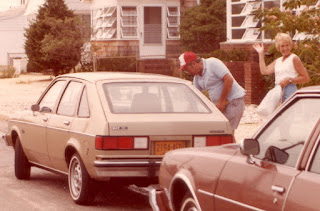For a couple of years in the early 1980s, the family car was a Champagne-colored Chevy Chevette. It looked more like “Army green” to me. During that snapshot in time, an increasing number of folks in the old neighborhood were giving fuel-efficient cars a fair look for the first time in their lives. On the heels of recent gas shortages and unwelcome price spikes, it made sense to drive vehicles without voracious fuel appetites. And, too, reducing energy consumption is always a good idea—for a whole host of reasons—isn't it?
My father owned a light blue 1959 Chevrolet Biscayne for fourteen years. In 1973, he bought a used 1968 Buick Skylark from a neighbor on the next block. It kind of sat on the road—you could almost walk into it. Eight years later, he was coaxed into purchasing the car that was—evidently—driving people happy. It was a noble experiment indeed to buy one with a manual transmission, no air conditioning, and back windows that would only roll down half way—a good gas mileage trifecta. Trouble was that Dad wasn’t exactly “Mr. Smooth” with the stick shift and the pool of alternative drivers was slim. So, when one added the lack of air conditioning and the back window thing to a never-ending series of shaky starts, summertime rides could get pretty hellish. The Chevy Chevette was retired after only a couple of years.
As I gaze upon the city streets three decades later, I see bigger than ever vehicles spewing more and more carbon dioxide into the air and taking up a whole lot of parking space, too. And all of this in an era of high gas prices and the general cost of living off the charts. Occasionally, though, I am heartened when I see a Smart Car whiz by me, but I worry its driver will one day be cast asunder by a runaway SUV or pickup truck. Perhaps it's noble experiment time again.
(Photo from the personal collection of Nicholas Nigro)

No comments:
Post a Comment
Note: Only a member of this blog may post a comment.